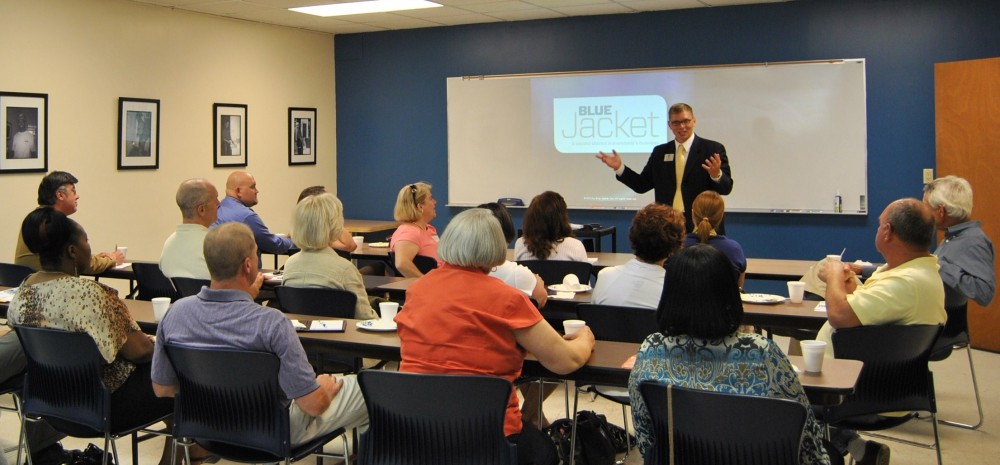(link to original Journal Gazette article including Blue Jacket graduate Jonta Powell)
National report looks at patterns of philanthropy
FORT WAYNE – How much people give to charity appears deeply tied to where they live, whether they are religious, how rich or poor they are, and – if they’re wealthy – how close they live to those who are not, a new report says.
A Chronicle of Philanthropy report released last week examines charitable giving by state, county, city and even ZIP code, finding that some areas give up to twice as much of their discretionary income to charity as others.
Some states, such as Utah and Mississippi, the report said, had the average household giving 7 percent of its income after taxes, housing, food and other necessities. But in four New England states, the average household gives less than 3 percent.
Households in Indiana donate an average of 4.5 percent of their discretionary income to charity, the report said, but noted that Hoosiers are generous in giving their time: Three in 10 said they volunteer at a non-profit organization.
The Fort Wayne metropolitan area gives 5 percent, ranking it 136th out of 366 metropolitan areas. But even within that area, giving rates differed wildly, the study found.
The highest median income – $82,399 – is in the 46814 ZIP code, covering western Aboite Township. There, households give 4.6 percent of their discretionary income to charity, the study showed.
Meanwhile, the lowest median income is in 46803, which covers East Central, the northern part of the city’s southeast side, and east to Riverhaven. Residents in that area have a median income of $38,334 but give 8.3 percent to charity – the highest percentage in Fort Wayne.
David Bennett, executive director of the Community Foundation of Greater Fort Wayne, said his agency has looked at similar data in the past.
“We found the same thing,” Bennett said. “You could call it a J-curve, where the lower incomes have higher giving, and it just keeps going down as income goes up, until you get to the very, very high end where they’re creating foundations and making major contributions.”
Bennett was also not surprised that the Chronicle of Philanthropy study showed that wealthier areas far from poor areas give less, while wealthy people in more economically diverse areas gave more.
Nationwide, people with incomes of more than $200,000 a year give an average of 4.2 percent to charity, the report said, but in ZIP codes where those making more than $200,000 a year are more than 40 percent of the taxpayers, that percentage drops to 2.8 percent. The fewer poor people there are in an area, the less the wealthy give.
Bennett said that regardless of income, people give to causes that move them. And if people are exposed to those in need, they tend to give accordingly.
“People are going to give to something that means something to them personally,” he said. “Even if it’s just driving past something, it’s still meaningful to them.”
Marilyn Fauth, coordinator of the Allen County Public Library’s Paul Clarke Nonprofit Resource Center, said those in need can often be out of sight and thus become out of the mind of those most in position to help.
“The people that are less well-off are closer to the pain and suffering of those they give to,” Fauth said. “I think that those that don’t give, especially people who have been well-off a good part of their life, who didn’t suffer meal-less days as children, they’re not close enough to it.”
But those who work with the poor often remark about the generosity of those for whom giving is a real sacrifice. Food bank workers talk about people on fixed incomes – who are sometimes clients – who give a few dollars every month. School principals talk about children who donate to food drives, though their parents will likely be getting food from that same food bank a week later.
The Community Foundation’s Bennett said many times that happens because it’s a way for people to pay back the generosity that was shown to them.
“I’m sure there’s a significant number of people who say, ‘When I needed it, they were there for me,’ ” Bennett said.
The southeast side of Fort Wayne, covered by the 46806 ZIP code, has a median income of $42,145, the second-lowest in the city. But, according to the study, residents there give 7.6 percent of their income to charity, the second-highest in the city.
Fauth said that while she believes the numbers, it is hard to grasp just what a sacrifice some people are making.
“If someone in the middle class tithes, gives 10 percent of an income that’s under $100,000, that is quite a lot of money,” Fauth said. “But 10 percent of a billionaire’s salary, it is a huge dollar amount, but it doesn’t affect them as badly.
“These people are giving till it hurts.”
Much of the giving may be faith-related.
The study found that of the top nine states for giving, two have high numbers of Mormons, who have a tradition of giving 10 percent of their income to the church. The rest are in the Bible Belt, where church-membership rates are higher than average.
If you take out giving to religious causes, the study found, the picture changes dramatically: New York moves from 18th most charitable to No. 2, and Pennsylvania goes from No. 40 to No. 4.
Fauth said faith is such a big part of why people give and accounts for such a large portion of contributions that it has to be taken into account in any study that’s done.
“Church giving is huge,” she said. “It can skew the numbers heavily.”
